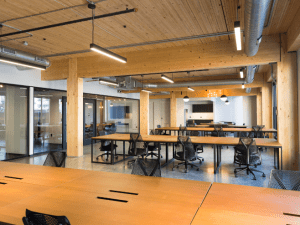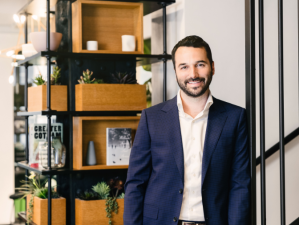What Makes a Good Flex Space Location: Industrious’ CEO Weighs In
Following the company’s rapid expansion, Jamie Hodari discusses the dynamics that are driving the nation’s coworking markets.
Demand for flex and coworking spaces continues to grow at a fast pace, with occupancy rates nearing pre-pandemic levels due to persisting interest from both investors and tenants. As of April, there was 115 million square feet of shared office space in over 5,600 locations across the nation, according to CommercialEdge, and those figures will likely only improve as more providers enter the sector or expand their footprint.
One of the most active flexible workspace providers, Industrious, is currently operating a portfolio of more than 160 coworking locations across 65 cities around the country and abroad. Commercial Property Executive asked CEO & Co-Founder Jamie Hodari to talk about the strategy behind the company’s expansion, and growth plans in the current economic context.
READ ALSO: As Hybrid Work Expands, Coworking Is No Longer the Exception
The flex and coworking market has been driving the office sector’s bounceback. What are the main factors behind the growth of flex space?
Hodari: The main factors benefiting the flex sector are the overall shift in the way people work and the near-ubiquitous desire for more flexible work arrangements. Most people now prefer to work in an office a few days a week and want to find local, low-commute options. When they do take larger spaces, they want them to be turnkey and de-risked, which requires a flex provider to deliver.
Traditional offices are still struggling following the pandemic, and the current economic landscape is adding to its woes. How are your partnerships with office landlords evolving in the current dynamic?

Industrious North Loop, a 34,000-square-foot coworking space in Minneapolis. Image courtesy of Industrious
Hodari: One interesting dynamic at play between traditional office spaces and our work is the flight to quality that is evident in long-term leasing. However, the concept of ‘quality’ is often undefined. In our case, what matters most to tenants is having a dynamic, engaging workspace that people want to visit.
By collaborating with landlords to manage shared amenities and experiences within their buildings, we can enhance their overall appeal. The greeting experience, in particular, is a highly effective way to improve a building’s attractiveness. As a result, we have seen a significant increase in our work with landlords who are seeking thoughtful and impactful ways to upgrade their assets.
In a previous interview with CPE, you mentioned that lack of transparency was one of the main challenges in the coworking sector. Is that still the case?
Hodari: When I mention the lack of transparency in this industry, I don’t mean it in a shady sense. Rather, I am referring to the fact that industries like airlines and hotels have access to large datasets because all providers agree to anonymously upload their data. This allows for information such as city-wide hotel occupancy rates or nightly rates to be easily accessible.
Unfortunately, we don’t have the same level of transparency in our sector. While it’s not a major challenge, I do believe that over time, especially if the industry shifts toward management contracts, it would be helpful to have more information sharing.
Industrious has been in the coworking market for a decade now. How would you describe your journey so far?
Hodari: Our entrepreneurial journey has been wonderful so far. Building a fulfilling and humane product and having my childhood best friend as a co-founder has allowed both Justin and me to enjoy the highs of entrepreneurship.

Industrious Downtown Minneapolis, a 20,000-square-foot coworking space in Minneapolis. Image courtesy of Industrious
Tell us more about the best performing coworking markets in your portfolio. What is behind their success?
Hodari: The best markets and submarkets are typically mixed-use neighborhoods—places where people can both live, work and socialize in their downtime. These tend to be the most exciting for workers, regardless of their location. Whether it be in Asia, Europe, or the U.S., downtown areas with places to eat, drink, do karaoke and work tend to perform well, while those that are empty after 6 p.m. tend to be the weakest markets. This is a dynamic that many people are currently uninterested in.
READ ALSO: What Office Users Want in Flex Space Now
How do you choose your locations? What aspects do you pay attention to?
Hodari: Our approach differs from traditional leasing, where buildings crop up in submarkets that aren’t anyone’s first choice, yet companies would choose them to save a bit of money. With flex, people can ‘vote with their feet,’ which means we need to set up locations in submarkets where at least 50,000 people would choose to be over any other location. This means we may have locations in non-traditional office submarkets such as Crown Heights or Greenpoint in Brooklyn, rather than second- or third-tier commercial districts.

Industrious Harvard Square, a 21,550-square-foot coworking space in Cambridge, Mass. Image courtesy of Industrious
Since the beginning of the year, you’ve opened several new locations, including the ones in D.C., Charleston, S.C., Phoenix, and Cambridge, Mass. What makes those spaces stand out?
Hodari: The locations we have opened this year are like mini-15-minute cities in areas where people live, eat, socialize and work, and have access to quality restaurants, bars, or even yoga classes. We are excited about these locations because we have seen a strong early performance from these units.
You also told CPE at the end of last year that Industrious plans to add 1 million square feet of flex office space to its portfolio in 2023. How is that plan going?
Hodari: We have growth plans that are both measured and aggressive. We believe in the growth potential of our sector and our product, but we are also risk-focused. Therefore, we aim for a 35 percent annual growth rate rather than 100 percent during uncertain times like these.
How do you expect the flex and coworking market to perform over the next quarters, considering the looming recession everyone is preparing for?
Hodari: I believe that the flex market will perform well in the coming quarters. However, flex providers with overexposure to mega spaces, where companies like TikTok or Amazon take an entire building, may experience some challenges as their members give back those spaces. Industrious, which focuses largely on fewer than 50-person spaces, will likely have a strong rest of the year.








You must be logged in to post a comment.